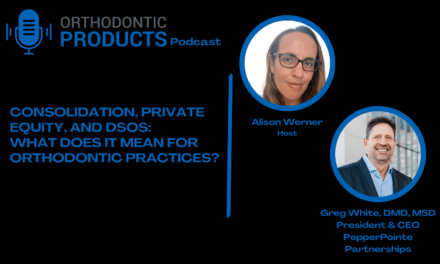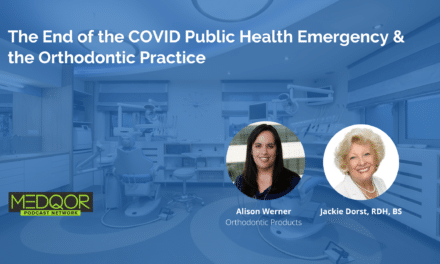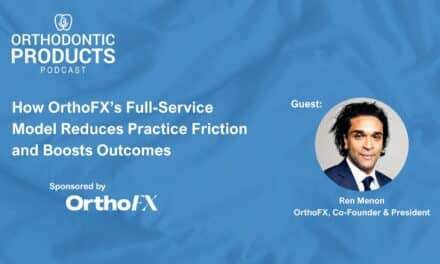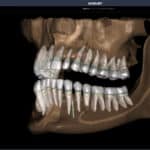OSHA and infection-control compliance are non-negotiable in orthodontic practice—but misinformation still leads many teams astray. In this episode of the Orthodontic Products Podcast, host Alison Werner talks with consultants Andrea Cook and Jackie Dorst about how secondhand habits, vendor tips, and social-media chatter can expose practices to costly violations and erode patient trust. They also outline reliable sources—such as the AAO Staff Club and the new AI-powered Ask ADS platform from the Association for Dental Safety—that provide clear, up-to-date guidance.
The conversation opens with the problem of “hand-me-down” protocols: assistants often carry procedures from previous jobs without realizing regulations have changed. Cook and Dorst stress that state dental boards and OSHA inspectors want current documentation, not verbal assurances. Strong, written systems not only protect patients but also serve as a selling point when competing for top clinical talent.
Andrea Cook, a clinical consultant with more than 20 years of chairside experience, focuses on OSHA compliance, sterilization-room design, and workflow efficiency. Jackie Dorst, a microbiologist and dental hygienist, is a nationally recognized speaker on infection prevention and OSHA safety. Together, they explain what inspectors look for, where practices stumble, and how to build compliance into everyday operations and team culture.
What We Discussed:
-
Inherited protocols that bypass today’s rules: Cook and Dorst describe how “we’ve always done it this way” often ignores new requirements—such as water-line testing—that can trigger citations and erode community confidence.
-
Infection control as a recruiting tool: Prospective assistants now vet employers for safety standards; a documented system can tip hiring decisions in a tight labor market and reduce turnover.
-
Untrained staff in sterilization roles: Summer temps or cross-trained front-office staff may mean well, but without proper onboarding they can sabotage sterilization cycles and expose the practice to liability.
-
Trusted education pathways—not sales pitches: The AAO Staff Club offers annual, peer-reviewed OSHA CE, while Ask ADS delivers AI-generated answers sourced from state dental boards, OSHA, and CDC guidance—no product agenda attached.
-
Designating (and protecting) a compliance champion: Successful offices allocate paid, uninterrupted time to an OSHA/Infection-Control coordinator empowered to audit, train, and update protocols.
-
Why leadership starts with the doctor: Even when tasks are delegated, regulators hold the practice owner responsible for ensuring PPE use, documentation, and staff training meet the current standard of care.
Key Takeaways:
-
If it isn’t documented, it didn’t happen—inspectors expect proof, not anecdotes.
-
Robust safety systems boost team morale, support recruiting, and shield the practice from reputational harm.
-
Stop relying on legacy habits: invest in credible education and give your compliance leader the authority and time to do the job right.
Chapters
00:00 Introduction to OSHA and CDC Compliance
02:52 Information Sources and Challenges
06:08 The Importance of Training and Competence
08:57 Reliable Resources for Compliance
12:00 Navigating Guidelines and Regulations
14:56 Addressing Common Questions and Misconceptions
21:55 Importance of Documentation in Dental Practices
24:31 Virtual Walkthroughs and Compliance Checks
27:19 Resources for Compliance and Record Keeping
29:30 The Role of OSHA and Infection Control
32:20 Understanding the Impact of Inspections
36:18 Training and Empowering Staff for Compliance
40:56 Connecting with Experts for Support
Resources Mentioned:
- AAO Staff Club (annual OSHA & infection-control CE): https://www2.aaoinfo.org/aao-for/staff/
- Association for Dental Safety’s Ask ADS site (a free AI beta for evidence-based answers): https://www.myads.org/ask-ads
- CDC Guidelines for Infection Control in Dental Settings: https://www.cdc.gov/oralhealth/infectioncontrol
- Andrea Cook’s OSHA Inspection & CDC Infection Prevention Compliance Checklists: https://www.andreacookconsulting.com/forms-downloads
Guest Contact Information:
- Andrea Cook:
- Website: andreacookconsulting.com
- Jackie Dorst:
- Email: [email protected]
- Phone: +1 949-842-1747
- Website: jackiedorst.com
Previous Episodes Featuring Jackie Dorst:
Podcast Transcript
Alison Werner (00:03)
Hello and welcome to the Orthodontist Products Podcast. I’m your host, Alison Werner.
In this episode, I’m joined by orthodontic consultants, Andrea Cook and Jackie Dorst to talk about OSHA and infection control, but more specifically about how to avoid misinformation that could leave your practice vulnerable to compliance issues that impact patient safety, team trust, and the bottom line. We also talk about where you can find credible guidance and centralized updates. So let me give you some background on Andrea and Jackie. Andrea Cook is a clinical consultant who specializes in OSHA compliance, infection control protocols, and establishing sterilization room systems. With over 20 years of chair side experience,
She also works with orthodontic teams to improve clinical efficiency, implement new technology, streamline training, and support overall workflow development.
And back with us again is Jackie Dorst, a frequent contributor to orthodontic products. Jackie, a microbiologist and dental hygienist by training, has over 30 years of experience in the industry and is a nationally recognized speaker and consultant on infection prevention, sterilization, and OSHA safety as well. Her science-based approach has informed professionals at leading industry events worldwide, including the AAO. Not only will they talk about the risks of relying on outdated or informal advice and the resources that can help your practice stay compliant, they will also talk about why infection control and OSHA protocols are more than
just checklists. They’re part of what attracts quality team members in a tight labor market. They also weigh in on who should be responsible for overseeing these systems and how to ensure your entire team is on the same page. Andrea and Jackie mentioned a number of resources in this episode so be sure to check out the show notes for links to those resources and with that here’s our conversation.
Alison Werner (01:35)
Jackie, Andrea, thank you so much for joining me today. I really appreciate it.
Jackie Dorst (01:39)
it’s good to be here with us, Alison.
Andrea Cook (01:40)
Thank
Alison Werner (01:42)
you
Andrea Cook (01:43)
for having us and letting us talk about the fun
of OSHA at CDC.
Alison Werner (01:49)
Exactly. So as I said in my intro, we’re going to talk about how your practice gets its information about CDC and OSHA compliance. Are you relying on that one team member, what they did at their old practice or something you found on the internet? We’re going to talk about why it’s important to look to the experts to get information about infection control, sterilization, other issues to keep your patients and staff safe. So Jackie and Andrea, what?
Has your experience been with this, how people get their information? What have you heard on the ground or seen on the ground?
Jackie Dorst (02:25)
Andrea, you’re in touch with the clinical team, sometimes more than I am. I’m going to let you feel that question.
Andrea Cook (02:32)
Well, it started very heavily during COVID. There were so many formats out there, so many Facebook groups, was a lot of conversations going on. And that’s when I got even more involved with the Facebook groups trying to guide them a little bit. But everybody was looking for answers. It slowed down a little bit, but those groups are still out there. And sometimes they have good information and sometimes they have information that’s not based on the current regulations, but based on…
what I used to do in my old office, what I did in residency, what Suzy, we just hired her and she was the OSHA coordinator at the other, her previous office. So obviously she has all the answers, so we’re going to change. And they’re following that without looking, relying truly on what the guidelines say and what we need to do. It’s not fun. It’s a lot of reading that is written in a format for our team members to really
Alison Werner (03:12)
Yeah.
Andrea Cook (03:30)
read and filter out the information. It’s tough, but relying on people, ⁓ your reps, sometimes I’ll have a dental rep that’s very educated, knows what they’re doing. And sometimes I have a rep that really doesn’t understand, but is going to offer solutions for you. We really just have to know what the guidelines are.
Alison Werner (03:33)
Mm-hmm.
Mm-hmm.
Okay.
Andrea Cook (03:54)
Go to resources, Jackie and I know the guidelines inside out, upside down. That’s a fun fact about us. ⁓ But those reliable sources that don’t have… Jackie and I work for our doctors. To get information, they come to us and we filter the information, whether it’s which sterilizer, what protocol. We work for you to find the solution. We don’t have a ⁓ tool we’re trying to sell.
Alison Werner (04:01)
Hahaha
Yeah.
Andrea Cook (04:23)
that ⁓ I want you to buy. So I’m going to say that’s the best one. So that’s what I’m seeing is there’s just nobody really knows and there’s just a lot of information out there that’s scary.
Alison Werner (04:26)
Mm hmm. Yeah.
Yeah. Jackie, what about you?
Jackie Dorst (04:40)
agree with Andrea 100 % and we get the same emails and text messages that might be one sentence of, Jackie, what do we do when this happens or I’ve just been nominated as the OSHA coordinator and I don’t have a clue about where to start. And they really, want to, the assistants want to do their best. They want to help their doctor, but they’re juggling.
Alison Werner (04:58)
you
Jackie Dorst (05:06)
clinical, seeing the patients, keeping that schedule on time and ordering supplies and balancing the budget and managing. So there’s a lot of different hats that they’re wearing. And sometimes we go to the easiest source, which might be a sales rep. And as Andrea said, some of them are very well educated. And Andrea, I find out some of them are very well educated on dental.
but really not ortho-specific as much. And ortho, mm-hmm, ortho with their open bay design and patients, mean, in ortho, we’ll see 60 to 120 patients a day for one orthodontist. Now, if you’ve got a group practice, it could be even more. That’s a heck of a lot more instruments, a lot more turnover of chairs, and you’re working in that community open bay situation where parents are in the room.
Andrea Cook (05:34)
Yes.
I see that a lot.
Jackie Dorst (06:05)
and they can see what’s going on and are observing everything. And actually, whether you’re practicing to the standard of care with OSHA safety and infection control can impact patient’s perception of the quality of your orthodontic care and your infection control. I often have, not every patient’s knowledgeable, but if they’re in healthcare or have been involved in healthcare,
⁓ You know, they’re going to observe, do you sanitize your hands every time you remove your gloves? Now that can be a soap and water washer, it can be an ABHR, but the OSHA law states sanitize every time you remove your exam gloves, and CDC guidance states the same thing. And say a mom or a dad that’s a nurse at the local hospital is sitting there watching on that first visit at the ortho office,
Now there’s a question and mom will bring it up and may even go to another ortho office. Andrea, have you experienced any of that?
Andrea Cook (07:12)
Yeah, I just had a call a few weeks ago from an orthodontist called in a panic and said a dad was in with their child and was it back in the bay and observing this procedure and called her. mean, luckily he did call her and give her a flat heads up. But he said, I noticed the instruments inside that sterilization pouch. The indicators on that pouch have not changed colors. So I’m questioning whether you’re sterilizing your instruments.
And her defense was we use a dry heat sterilizer. We put them in the pouch after they come out of the sterilizer and then take them chair side. And I said, well, that’s not following the guidelines. And she, you know, just like we talked about Jackie, the orthodontist I bought the practice from did it that way. So we kept doing it. And I said, well, it’s not within the guidelines. Here’s what the guidelines say. So unfortunately, the father is correct. And I would, you know, call and
You know, she wanted specifics out of the CDC guidelines to cite to him and I said, I wouldn’t go there. I would gently make it. You know, yes, we realize, we apologize. We’re, you know, implementing systems to correct that. But she had just been doing it because that’s what the old orthodontist that she brought the practice from did. She said, well, I thought that was okay. So yes, I am seeing it. I’m also seeing it from people who come in for interviews.
Alison Werner (08:20)
Yeah.
Andrea Cook (08:41)
They’re noticing these things. And I’ve had a couple of reports to OSHA from an employee, a potential employee that came in for an interview and then said, hey, this is not right. This is not safe work environment. So we need to be aware of those as well. It’s the patients and the parents, but it’s also anybody that’s in your practice, whether it’s an applicant or a summer intern, whatever it is.
Alison Werner (08:50)
candidate.
⁓
That’s really interesting.
Jackie Dorst (09:07)
Yeah.
Alison Werner (09:08)
Yeah,
yeah, absolutely.
Jackie Dorst (09:09)
Yeah. I would add to that that ⁓ you just brought up Andrea how important it is for having those excellent comp.
competent orthodontic assistants and we’ve all heard about the shortage during the pandemic and it’s continuing even now and we’re resorting to hiring employees who may not have had orthodontic experience but they come in with the right attitude. You know they’ve got a great attitude, they have the potential for being a superstar orthodontic assistant.
And we need to provide them with correct training, get them started in the right way. And that’s a real challenge because orthodontics is unique. ⁓ we do, and I say unique, different between the general dentist and the oral surgeon and the periodontist and to your doctor that said, well, this is, we put the instruments in the pouch after they come out of the dry heat sterilizer. She didn’t know she was continuing with it.
Andrea Cook (10:00)
Mm-hmm.
Yeah.
Alison Werner (10:11)
Mm-hmm.
Jackie Dorst (10:12)
And it makes me even question that office about how are they sterilizing their hand pieces? Because you can’t put hand pieces in a dry heat sterilizer. And those hand pieces…
Andrea Cook (10:23)
There are so many questions after we have this conversation
and discussions that we had after. So there’s a site visit plan to get her back on track. One of the things I wanted to mention is, Jackie, you were talking about training. One of the things I see in summer is somebody will hire, you know, Mary up front, her child’s in college. So we’re going to bring them in and they’re just going to do sterilization during the summer. It’ll be easy. Yeah, just do that. So they bring them in, they don’t train them.
Jackie Dorst (10:31)
Yeah. ⁓
Yeah.
Andrea Cook (10:53)
They don’t give them anything and that’s the most at-risk person in your office. Somebody who is strictly doing sterilization with absolutely no training. You just opened yourself up for high, high risk. So that’s one thing that scares me in the summer. Jackie, do you agree?
Alison Werner (11:03)
⁓
Jackie Dorst (11:12)
Yeah,
Alison Werner (11:13)
wow.
Jackie Dorst (11:14)
I agree. And you know that comes around to having those written training protocols and job descriptions and having that to go through with new employee orientation and onboarding and huge risk for ⁓ having a non trained person in the sterilization area because Andrea and you and I have said so many times, sterilization is not like horseshoes. You don’t get close.
Andrea Cook (11:40)
No.
Or it’s not.
Jackie Dorst (11:41)
It’s either sterile or it’s not sterile. Yeah.
And there are too many potentials for breaches ⁓ in the sterilization process to risk having a non-trained person. So that said, ⁓ if I’m an orthodontist and I either, maybe I’m a doctor who’s been practicing for 20 or 25 years and I’m looking to make certain that all my systems are up to date, where do they go for information?
Or if I’m a young orthodontist coming into practice, where do I go for information or even the orthodontic assistant? And that finding that reliable information is a real challenge with it. And I’d like to offer a couple of resources because Andrea and I love going into offices and we love doing the webinars and Zoom meetings, but even as busy as we are, we can’t get with every orthodontic office. And there are a couple of resources.
Alison Werner (12:26)
You
Jackie Dorst (12:36)
The American Association of Orthodontists has the AAO Staff Club. And it’s an online CE continuing education, but a training program and the whole team can join for $75 a year. And they have an online OSHA program that is updated every year. It’s within a one hour timeframe. You can take the course and then you get your CE certificate.
Alison Werner (12:52)
okay.
Jackie Dorst (13:04)
And it’s the basics. It requires the OSHA coordinator or the OSHA leader in the office to go back and customize for that particular office’s situation, such as how do they sterilize? Where are the fire extinguishers located? Where’s the eyewash station? And how do you operate it? All of those things. But ⁓ I’m going to give the ⁓ AAO’s education director her email address if that’s OK with everybody because she’s new. She has just joined. Her name is Tori.
Andrea Cook (13:17)
Yeah.
Alison Werner (13:18)
Okay.
Yeah, go ahead.
Jackie Dorst (13:34)
and her email address is vcannon, c-a-n-n-o-n, at a-a-ortho.org. So that’s a non-biased, non-commercial, no products being sold. It’s not like getting an OSHA training from your local dental supply rep that, hey, their goal is to sell product, you know, at the end of it.
Alison Werner (13:51)
Right.
Andrea Cook (13:52)
Yeah.
Alison Werner (14:00)
Yeah.
Jackie Dorst (14:00)
And
⁓ like I said, every year it’s current, it’s updated, and it’s a great starting point for that accurate information. And Andrea, to the sterilization point on that AAO site, there is a basic infection control training that I did about three years ago, but it’s still current with it. And then the second thing that I’m excited to introduce is brand new. It comes from the Association for Dental Safety’s
Alison Werner (14:24)
Mm-hmm.
Jackie Dorst (14:27)
conference that was held at the end of May, so it’s really recent, and ADS has now introduced Ask ADS. That is an artificial intelligence to answer all of these complex questions and provide the resources and the references with it. So again, for your listeners, I’m going to give them the website for it. It’s www.myads.org.
Alison Werner (14:47)
Okay. ⁓
Jackie Dorst (14:57)
forward slash ask ask dash ads and it’s available it’s open right now it’s available to everybody it is free it won’t be free forever right now it’s gone through the baiting beta testing it’s just been launched and ADS is encouraging all dental and orthodontic professionals to check in on it
Alison Werner (15:10)
Mm-hmm.
Jackie Dorst (15:25)
and give it a try because the little, it looks like a droid, you remember R2D2? Yeah? Well, that’s the symbol for it and her name is Betty. And you get to ask Betty a question and Betty does not like CHAT GPT. She doesn’t pull from public resources, but she pulls her information from dental and medical resources and from state dental boards.
Alison Werner (15:32)
Mm-hmm, yeah.
⁓ okay.
Jackie Dorst (15:53)
and from OSHA and she cites those references with it. So it’s really it’s specific for us but ⁓ Allison as you know using any AI the answer is only as good as question right?
Alison Werner (16:05)
You
Right, exactly. So you do have
to ask follow up questions and train it and get it to where it needs to go. But I wanted to ask you guys, know, given everything that’s happening with ⁓ Department of Health and Human Services and CDC and OSHA, how is
Where should orthodontic practices be looking for information if there is some dispute as to what is out there? Is it going to AAO? Is it going to this, going to ADS? Is that kind of the alternative to still feel like, okay, you have the best information that’s available and you’re maintaining those standards to keep your practices safe and your staff and patients safe?
Jackie Dorst (16:55)
Well, I’m going to jump in on that because I did just recently attend the ADS conference and this was a hot topic. It was top priority with the lack of funding, the closure of the oral health division at CDC. I will say to everyone, just because the oral health division at CDC has discontinued, the guidelines and the recommendations are still the same and they’re part of the state dental practice act.
Alison Werner (17:00)
Mm-hmm. Yeah.
okay.
Jackie Dorst (17:23)
So
most state dental boards will refer to the current CDC guidelines. Going forward to the future, there will be a needed resource for this non-commercial information and the Association for Dental Safety will step into that. Now I’m preempting a public announcement on this a little bit.
Alison Werner (17:30)
Mm-hmm.
Okay.
Jackie Dorst (17:50)
but there is endorsement from all of the dental professionals. The AAO, the ADA, the AAP, ⁓ all of the oral surgery group, the endo group, they all, because the Association for Dental Safety has been such a leader in infection control for over 40 years. And even when the dental unit waterline contamination was infecting patients,
Alison Werner (17:55)
Okay.
Mm-hmm.
Yeah.
Okay.
Jackie Dorst (18:19)
The Association for Dental Safety had been researching that and looking at it for over 35 years and had published the white paper on how do you manage dental unit waterline contamination and that in turn was adopted by CDC. So it became part of the Centers for Disease Control ⁓ with their guidelines and recommendations. Going forward, ADS will have an institute for dental safety and dental infection control.
Alison Werner (18:24)
Hmm.
Okay,
okay
Jackie Dorst (18:48)
So
this is and it will write the standards and the guidelines that in turn will be referenced and adopted by both OSHA and the state dental boards. And I’ll further go in and Andrea may add some more information. We do get a lot of conflicting ⁓ confusion I should say from orthodontist and from clinical team members about what is
Alison Werner (18:58)
Okay.
Jackie Dorst (19:18)
an OSHA law and what’s a infection control guideline from the state dental board and from what was CDC going forward. It’ll be our standards. And I bet you run into that all the time, Andrea.
Alison Werner (19:23)
okay.
Andrea Cook (19:33)
There’s a huge confusion between what OSHA is and what CDC and your state dental board is. And I’m going to go back to our original when we first started talking was when you get these questions about what do I do, go to reliable sources. Go to your state dental board, CDC, OSHA. I know it’s hard to gather the information or go to an independent resource that understands the guidelines.
Alison Werner (19:46)
Mm-hmm.
Yeah.
Andrea Cook (20:00)
knows
them and that can guide you towards compliance versus this is what we did in our old office, I have this new product that’s going to take care of that for you. Those are ⁓ opinions and I encourage fact finding.
Alison Werner (20:08)
Mm-hmm.
Jackie Dorst (20:16)
or this is
Alison Werner (20:18)
Well, and I know just in talking to you guys, you know, you said like a practice might come to you with a one sentence question, but that response from you.
your research that could take you hours to answer that question to compile all that information, which is maybe not a one sense response. It could be an entire document or a group of documents. So it takes time to answer those questions. It can’t just be a quick, you know, you can’t you can’t just, you know, expect it to turn around. Yeah, yeah, exactly.
Andrea Cook (20:49)
Yes. Yeah.
Jackie Dorst (20:50)
Yeah.
And we have to be very cautious about what we do reply in emails or text messages because it gets shared and we’re dealing with laws with both OSHA laws and dental board laws and that could wind up having further further ⁓ influence let’s say with it. So it is you know having these resources
Alison Werner (21:16)
Yeah.
Andrea Cook (21:18)
Yeah.
Jackie Dorst (21:20)
that are reliable is so important ⁓ for the team members and not going to well in my Facebook group they said you know or in this this Purchasing group they said because I see a lot of information posted that is not correct
Alison Werner (21:23)
Yeah.
Right.
Yeah.
Right, absolutely.
Andrea Cook (21:39)
Yeah, it’s funny, sometimes
in some of the groups somebody will post a question about what do do about this? And I find it interesting and scary to hear the responses because I hear a wide gamut and 90 % of them may not be within compliance, but it’s based on what we do in our office or things like that. And so that’s how they’re gathering their information. And I think it’s…
Alison Werner (21:46)
⁓
Mm-hmm. Mm-hmm.
Yeah.
Andrea Cook (22:07)
It’s just scary. don’t want to see people going down a path that’s not in compliance and can put them themselves, their practice or their patients at a risk, higher risk than they already are at. So.
Alison Werner (22:08)
Yeah.
Yeah. Yeah.
Is there ⁓ a theme or a common question that you see from staff or practices that pops up a lot in those kind of groups that just keeps being brought up over and over again? what are the top three questions you get regarding OSHA or?
Andrea Cook (22:37)
My first one is do
we really need to follow the OSHA and CDC guidelines? And yes you do. That’s the first one. Because it’s kind of big and yeah, no, yes you really do need to follow them for your own safety, for the safety of your practice and your patients. There’s a lot of questions on training and documentation now that people are not understanding what they need to do. ⁓ I think there’s more focus from CDC, State Dental Board and OSHA.
Alison Werner (22:41)
okay. Okay. Yeah, yeah, right.
Andrea Cook (23:03)
on having documents, protocols, logs, things like that in place. And it’s just not happening in our offices. A lot of it is based on, I don’t know what to do. I don’t have time to do it in the first place and I don’t have time to investigate. I’ll figure it out later and it just doesn’t get done.
Alison Werner (23:16)
Yeah. Yeah.
Yeah.
Jackie Dorst (23:23)
Andrea is so right and I love the quote, if it’s not documented, it did not happen.
Alison Werner (23:31)
Yeah.
Jackie Dorst (23:31)
If you don’t, if you can’t,
if that OSHA inspector showed up or the state dental board or the health department and they’re asking for a document on have all of your clinical employees been vaccinated for hepatitis B and you can’t produce the paperwork, then it didn’t happen and you have a citation. Same thing with say your sterilizer. Do you have sport test records that you could produce?
Alison Werner (23:50)
Yeah.
Jackie Dorst (23:59)
And you know, Andrea, one of the things that I’ve been running in ⁓ in the last couple of years, I like to do a virtual walkthrough with an office before I do an online training. Best is when I can go into the office and actually see their physical facility and what they’re doing. But we can’t be everywhere. It’s not geographically possible. So I come up and they have the assistant call me on a FaceTime call.
And we go through a checklist and they’re walking through the office and showing me where their OSHA poster is and showing me their sterilization room. And the most frequent thing that I run into is I go, OK, are you treating your dental unit water lines? And they go, yeah, we we have a tablet or yeah, we’re using the straws in them. And then the next question, if you you just go with that yes or no question, you don’t get the background on it. And I go into, OK, which product are you using?
And when do you shock? Shock? Are you supposed to shock? Yeah. dear. And then the next question is, how are you testing your water lines? And that’s the same, “test?” We’ve never, how do we test? And that water line test is documentation, just like the sport test is on the sterilizer. And now state dental boards are requiring it.
Andrea Cook (24:58)
That’s that shocked look on their face. Yeah.
Jackie Dorst (25:24)
We’re seeing both Georgia and Washington state have passed laws that require and specify how often the testing has to be done and how long those testing records have to be maintained. And that’s a critical step that I’ve seen that many orthodontic offices have not implemented with their orthodontic unit waterline management.
Alison Werner (25:45)
like a,
Andrea Cook (25:45)
I have the same
Alison Werner (25:46)
it sounds like a.
Andrea Cook (25:46)
look on their face
when I ask them if they’re testing. It’s like.
I don’t know.
Alison Werner (25:52)
Well, then it sounds like a lot of the issue is record keeping.
Andrea Cook (25:58)
That’s a huge piece of it that is not happening in offices based on time or I don’t know what to do. And it’s a huge piece of what they are looking for when you get a visit from any of the regulatory bodies. That’s what they want is documentation. They don’t care if you say, you know, I’ve done a spore test every week. I’ve tested my water lines. Like Jackie said, if it’s not documented, it’s not done and you’re going to be held accountable for that. So
learning what you need to do as part of it, then getting the protocols and documents set up to make sure we have our logs and make sure that we maintain that consistency between team member turnover that we’re experiencing at high level. Things just fall off. just, well, Mary used to do that and I don’t know, it just stops happening. So those are key pieces right now. Yeah.
Alison Werner (26:44)
Right. Yeah, absolutely.
Jackie Dorst (26:52)
or Mary had a baby, Mary had a baby,
went out on maternity leave, decided not to come back, and then nobody else picked it up and it fell through the cracks. Yeah.
Alison Werner (27:02)
or
we don’t remember where the file is on the computer. Because I know I’ve heard Jackie talk about that one. ⁓ With those AAO resources and the ADS resources, do those resources talk people through the record keeping that they need to do? And what they should have on file?
Jackie Dorst (27:05)
Yes!
Andrea Cook (27:06)
That’s all.
Jackie Dorst (27:08)
Yes.
the Ask ADS is not. It’s only a AI answer questions type device. Now I know that I as a consultant, I have a one page checklist that I go through and you know that sort of summarizes. I know when we’ve done the In the Sterilization Room with Jackie ⁓ episodes during the pandemic, we provided that
Alison Werner (27:26)
Okay.
Okay. Okay.
Mm-hmm. Yeah, I remember we’ve talked about that. Yeah.
Jackie Dorst (27:49)
I’m sure Andrea does too. Andrea, do you have that available on your website?
Andrea Cook (27:54)
Yes, I have two checklists on my website. So it’s andreacookconsulting.com. There’s a tab that says downloads and there’s an OSHA compliance checklist and a CDC compliance checklist. This does not take into account any state specific. This is a general CDC guideline, but it’s a good place to start. Anytime you check, yes, we have that and it’s up to date, you’re okay. Any of the boxes that you check, no, that’s an area for improvement.
Alison Werner (28:10)
Right, right.
Andrea Cook (28:23)
or change for your office and that’s when you’re going to have to begin the investigation of, okay, we’re not doing that. So we’re not testing our dental water lines, dental water lines. What do I need to do and how do I need to document is the next step, but at least identifies it and gives you a place to start. So.
Alison Werner (28:34)
Mm-hmm. ⁓
Yeah.
Jackie Dorst (28:43)
And I’m going to add to Andrea’s with it because that’s a great resource that’s orthodontic specific. And Andrea is much better at digital management and virtual connection than I am. I’m still a little bit behind the curve on that technology with it. However, I would encourage that every orthodontic office should have their infection control leader ⁓ and or their OSHA.
Andrea Cook (28:50)
Yes.
Alison Werner (28:55)
You ⁓
Hahaha!
Jackie Dorst (29:11)
leader and those are two different things. Remember, although OSHA and infection control overlap, but they should be a member of the Association of Dental Safety. It’s not an expensive membership and they will get the latest, most current information, a monthly ⁓ video training with it, a bi-monthly infection control in practice, continuing education newsletter that focuses on it. Membership is only $125 for a whole year.
I’ve been a member since I began speaking and consulting, and I it was one of the first things when I met Andrea and she said, this is an area that I see as a real weak point for orthodontic offices. They need clinical help. I said, join the Association for Dental Safety. That’s the best accurate information resource. So I would highly recommend spending that $125 and having at least one team member join.
Andrea Cook (29:45)
You
The other thing I’m going to add, we touched on this earlier though, was please give your infection prevention and your OSHA coordinators time to do these things. This does not happen in between patients when I’m trying to seat one and it’s four o’clock and then I have to go do this and I have to get the scan. That’s not how this happens. It happens when I can sit down and I can think it through, I can investigate if you use my checklist and there was an area for no.
Alison Werner (30:12)
Mm-hmm.
Yeah.
Jackie Dorst (30:20)
Yes.
Andrea Cook (30:38)
I have to have time to look at the resources that are going to guide me. So this doesn’t happen between patients. This is, I need some time set aside where I can just be, have it be quiet and I can focus and get this done. Otherwise it’s not going to happen.
Alison Werner (30:54)
Yeah.
Well, and then what is the cost of not having it in place? What are some of the penalties we’re talking about here? There is reputational, you know, a penalty, like you said, with that father who spotted the the indicator wasn’t there on the sterilization. What is he going to tell other parents? Right, exactly. But then there’s also fines and ⁓ complaints against as well.
Jackie Dorst (30:55)
⁓ thank you.
Andrea Cook (31:13)
Could he possibly post something? Possibly.
Jackie Dorst (31:22)
and not getting the quality employees. The employees who are knowledgeable and want to work in a state-of-the-art orthodontic practice look for an employer who is concerned about their safety and well-being.
Andrea Cook (31:23)
Yeah.
Mm-hmm.
Jackie Dorst (31:40)
who has all of those systems in place, not that it’s helter-skelter, and then you’ve already got the systems and as you hire new employees, you have the right way to onboard them and train them and insert them into your orthodontic clinical team.
Alison Werner (31:53)
Yeah.
Absolutely. Absolutely.
Andrea Cook (31:59)
But I don’t know the
OSHA fines right now Jackie, what are they? They’re over 2,000 per infraction.
Jackie Dorst (32:07)
16,000 per infraction could potentially be and if it’s a willful or a where you’ve been cited and you didn’t make the correction it can be up to 165,000 dollars per day. Yeah the OSHA finds go ahead
Andrea Cook (32:10)
Are they?
Alison Werner (32:18)
wow.
Andrea Cook (32:22)
Yeah, and
also the $160,000 hurts community reputation. You can’t get that back. Once that’s tainted, ⁓ I just advise you not to go there. Yeah.
Jackie Dorst (32:37)
Yeah, yeah.
Alison Werner (32:37)
Yeah, absolutely.
Jackie Dorst (32:39)
And OSHA inspectors, when they come to the office, it’s important for the team and the doctor to remember they’re not there for a confrontation. And they are industrial hygienists. They are not clinicians. They’re not sterilization experts. I know when the OSHA bloodborne pathogen standard was first passed, I was asked by several state OSHA
Alison Werner (32:48)
Mm-hmm.
Jackie Dorst (33:03)
departments to train their inspectors on what to look for in a dental office because they didn’t know what an autoclave was. They were not familiar with it. They’re familiar with our electrical outlets overloaded. Can you get out the exits and that other emergency preparedness with it? But when they come in, they do have their checklist to go through and you need to have a system for, you know, if you do have an inspector come in and it may not be OSHA. It may be the state dental, state health department.
Alison Werner (33:10)
Okay. Okay.
Jackie Dorst (33:33)
or the state dental board with it because I’ve seen more inspections from state health departments of dental and orthodontic offices since the pandemic than I’ve ever seen previously. Yeah.
Andrea Cook (33:45)
And you have to remember OSHA inspectors are real people. So I got a call from a doctor that said he was doing an initial patient exam for a child. So he was asking the dad that was there, so what do you do? You know, you’re off during the day, what do you do? And he said, well, today’s my day off, I’m an OSHA inspector. And the doctor said, his face just drained. He said, all I could think about was, are they wearing gloves? Where’s the OSHA manuals? What do I do? Did they have this in place? What is a?
Alison Werner (34:11)
no.
Andrea Cook (34:14)
He said, I have no idea what the kid’s teeth looked like because that’s all I could think of. He said, I walked out of the office from that new patient exam and said, you guys handle the clinic, I’m calling Andrea. So, and they’re real people and he wasn’t there doing an inspection, but you never know. That’s all.
Alison Werner (34:14)
Mm.
Ha ha!
the thing any inspector from any organization is going to either be a patient or have a child who might eventually be a patient. you know, because Jackie, I remember when we were doing the COVID ⁓ series, you talked frequently about, know, like, are you wearing the right mask? Are you wearing? Are you doing the hand hygiene? And you talked about a parent who was a nurse who came in and, know,
Who were they gonna tell that the practice wasn’t properly following PPE guidelines, you know, when they go back to work?
Jackie Dorst (35:10)
have a letter from, ⁓ that involved an orthodontic practice, let’s just say in the Northeast. And the mom that came in with the child for her son’s first bonding appointment with it observed several discrepancies and she wrote a detailed letter to the doctor about not, ⁓ not sanitizing hands in between, that the doctor came over to examine the child.
Alison Werner (35:17)
Mm-hmm.
Jackie Dorst (35:39)
with one gloved hand and not a glove. So I can just imagine the mirror, Andrea, can’t you? They’re just looking, do we have the right arch wire? Does everything look? But the other hand was ungloved. So she listed about five items that she observed during that appointment. And what her statement was, early in my son’s treatment, we now have a level of distrust throughout my son’s treatment.
Andrea Cook (35:46)
yes.
Jackie Dorst (36:08)
And as the infection prevention manager at the local hospital, I find these violations in contradiction to the state dental practice act and reportable to the state board. So she put that in writing. Not all patients will take the time to do that, but that’s a huge risk for the practice. She’s now a force multiplier.
She’s going to talk to every nurse she knows, all of the doctors, everybody at the hospital about what she, what they do at the hospital is great, but what they, my gosh, can you believe they did this at the orthodontic office? That’s, you know, community perception. And we work hard to treat patients. And doctors and clinical team, they care from their heart. And we change patients’ lives with the beautiful smiles that we create.
Alison Werner (36:48)
Mm-hmm. Yeah.
Jackie Dorst (37:05)
And when you get a comment like that, you feel like you’ve been kicked in the gut. We are managing this schedule. We try to do everything right, but they didn’t know.
Alison Werner (37:09)
Yeah.
Andrea Cook (37:16)
And that’s a lot of it. Most of the time I find infractions are, especially from like my team members. It’s not an intentional, I’m going to do this wrong or I’m not going to do that. It’s, I didn’t know, my doctor didn’t train me. The office I was at before did it this way, whatever it is, but the training, the fault file falls on the office as far as not setting those expectations and then holding team members to say, no, you have to do this.
Alison Werner (37:16)
I literally.
Mm-hmm. ⁓
Right. Right.
Yeah.
Andrea Cook (37:46)
following through with that. So a lot of it is, like I said, I’ve maybe had one intentional team member that was not following the rules, but most of the time it’s just lack of education and training and it comes back on the office. We got to do it.
Alison Werner (37:57)
Mm-hmm.
Yeah.
Who should be the leader in this implementation, in this keeping track of what’s going on in the office, of making sure that we are in compliance? Who should be the leader? A staff member who’s handling all this stuff, or should it be the orthodontist?
Jackie Dorst (38:18)
The doctor
has to set the tone. The doctor is the manager. The doctor sets the tone for the entire practice that this is a practice of excellence and that we are going to provide the quality care to the standard with it. And with that, then the doctor can delegate to the OSHA leader, to the clinical team manager. That’s the, to me, the clinical team manager is the ideal one to be.
Andrea Cook (38:20)
Yes.
Jackie Dorst (38:46)
the OSHA manager with it because they know which supplies we’re using, what the procedures are. It can’t be an administrative person who is distance from the clinical area, but without empowering that OSHA coordinator, they have no recourse to go to, such as you have a team member who will not wear her safety glasses. She doesn’t like them. She finds them uncomfortable.
Alison Werner (38:48)
All
⁓ okay.
All right.
Jackie Dorst (39:16)
The doctor is ultimately responsible from OSHA’s point of view that if that assistant who does not wear her safety glasses has an eye injury, she clips an arch wire and it goes flying into her eye, she’s spraying and rinsing off acid etch, it goes flying into her eye. If she has eye injury or even worse, blindness from that accident, then the doctor and the office is going to be responsible for that to OSHA and
to for the rest of that employee’s life under their liability with it. So ultimately the doctor is responsible and the OSHA law states that employers are required to ⁓ be certain that to provide the PPE for their patients, I mean for their employees, but to see that it is used.
Alison Werner (39:48)
Right.
Andrea Cook (40:07)
And I agree that the doctor is ultimately responsible. When I work with an office and we’re trying to develop the infection prevention coordinator, the OSHA coordinator, ⁓ I look at tasks that are on team members. Sometimes I have my clinical lead that is underwater. And I know if I put that task to them, it’s not going to get done. But I may have somebody
Alison Werner (40:16)
Yeah.
Mm-hmm. Right.
Andrea Cook (40:35)
that has a little bit more energy to bring to the table. They have to have an interest in OSHA, CDC, and in following the rules if they have that interest. So sometimes it’s not the lead or somebody who’s tired. It’s somebody who has an interest in it and they say, I can take that on. And that’s a great person. If you give it to somebody or ask somebody and they’re like, I’ll be nice. Yeah.
Alison Werner (40:46)
Yeah.
Right. Yeah.
Jackie Dorst (41:04)
Yeah, and Andrea and I are always looking for that spark, that clinical team member who goes, yes, I am passionate. ⁓ and then when we come in, they go, it’s so good to hear somebody else who feels the same way about this. And that’s the spark we want. Yes, the one who’s passionate about it, they will do a great job with managing it and inspire the rest of the team.
Andrea Cook (41:08)
Yeah.
Alison Werner (41:15)
That’s your person. Yeah.
Andrea Cook (41:16)
Yes, that’s your person.
Jackie Dorst (41:29)
And as I’ve learned from Andrea and all of the other great orthodontic consultants and speakers over the years, it’s so much more effective to inspire from the positive rather than to beat somebody over the head with the negative. And all of the emphasis that we can put on that is greatly needed because it is a huge task. And as Andrea says, the clinical leader can be underwater.
Andrea Cook (41:44)
Yes.
Jackie Dorst (41:57)
The office manager can be underwater with it and the doctor doesn’t know. The doctor is busy doing doctor things which we need them to do and they need someone that they can rely on.
Andrea Cook (41:57)
Mm-hmm.
Alison Werner (42:01)
Mm-hmm.
Right.
Andrea Cook (42:06)
Mm-hmm.
Alison Werner (42:09)
Absolutely. Well, thank you so much for joining me for this conversation. It has been a joy and I always love talking to you, Jackie and Andrea. It’s great to finally have you on. What’s the best place for people to get in touch with you, Andrea, they would like to work with you or get some help?
Andrea Cook (42:19)
I love it.
I say go directly to my website andreacookconsulting.com . You can contact me through email phone ever. All of my information is up there. The downloads start there and check and see what your level of compliance is and any of the knows I would love to work with you and help you get. More compliant, safer place for you and your team members to feel good and your patients.
Alison Werner (42:49)
You
Yeah,
exactly. And Jackie, you?
Jackie Dorst (42:54)
Yeah. Well,
Andrea, mean, Alison and Andrea, I have that website, although it does need to be updated. So I’m just going to give you my email address with it. It’s [email protected], S-A-F-E-P-R-A-C-T at gmail.com. And if you forget it, it’s on every one of those AAO presentations and webinars that are on the staff club site. So.
Alison Werner (43:02)
Alright.
Jackie Dorst (43:22)
If not, Google me or get in touch with me and sometimes it’s a text message with a photo that helps. So I’m even going to give you my cell phone number 949-842-1747 and have a safe, sparkling summer in your orthodontic practice.
Alison Werner (43:42)
Absolutely. And we will have a link to all those resources that have been mentioned, including their contact information in the show notes. So again, thank you, Andrea and Jackie, and we’ll see you for the next episode. Bye.













